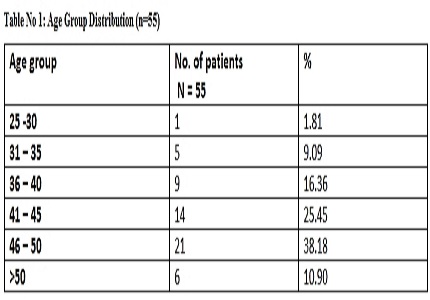Clinical study of uterine Leiomyoma and its associated risk factors
Abstract
Introduction: Uterine leiomyomas have historically been viewed as major indication for hysterectomy. As new therapies have developed, the heterogeneity of this disease has become therapeutically relevant. An awareness of the role of risk factors, growth factors, hormones and genetics in tumor etiology is the key to understanding of this disease. This study was undertaken to know the various risk factors associated with uterine leiomyoma.
Objective: To Study the clinical features and various risk factors associated with leiomyoma of uterus.
Materials and Methods: This is a hospital based prospective study of 55 uterine leiomyoma cases. After taking consent all cases were enrolled into the study and detailed history regarding mode of presentation, clinical features and various risk factors of uterine leiomyoma was taken, all cases underwent transvaginal ultrasound to know the location of leiomyoma. Specimen of leiomyoma was sent for histopathological examination and analysed.
Results: Mean age group of the cases was between 41 – 50 years. Mean age at menarche was 12.9 years. Maximum numbers of cases were in the group of PARA – 2. Abnormal uterine bleeding like Menorrhagia, Polymenorrhea, Metrorrhagia, and Dysmenorrhea were the most common modes of presentation followed by pain and increased urinary frequency. In the present study 49.09% of subjects were above normal BMI range. Individuals with sedentary life style were at higher risk of developing leiomyoma. Intramural was the commonest location of fibroid followed by subserosal and submucus fibroids. On Histopathological examination, leiomyoma was confirmed and Cervicitis was the most common accompanying feature followed by adenomyoisis and degeneration.
Conclusion: Leiomyoma of uterus is multifactorial in origin with various factors acting in conjunction. Increased oestrogen exposures due to factors modulate myometrial cells and act as tumor promoters. Reproductive age of patient, early menarche, obesity and parity are most common risk fctors which modulate estrogen response.
Downloads
References
2. Lumsden MA, Wallace EM. Clinical presentation of uterine fibroids. Baillieres Clin Obstet Gynaecol. 1998 Jun;12(2):177-95. [PubMed]
3. Sandberg AA. Updates on the cytogenetics and molecular genetics of bone and soft tissue tumors: leiomyoma. Cancer Genet Cytogenet. 2005 Apr 1;158(1):1-26.
4. Cramer SF, Patel A. The frequency of uterine leiomyomas. Am J Clin Pathol. 1990 Oct;94(4):435-8. [PubMed]
5. Flake, Gordon P, Janet Anderson, Darlene Dixon. Etiology and pathogenesis of uterine leiomyoma -A review; Environment health perspect 2003; 111: 1037 - 1054.
6. Farestien E, Moyses Szklo, Neil Rosenshein. Uterine leiomyoma a practice based case control study -African American heritage, reproductive history,body size and smoking. American Journal of Epidemiology 2001;153(1):1- 10.
7. Mohammed NB, NoorAli R, AnandaKumar C. Uterine fibroid: clinical presentation and relative morbidity of abdominal myomectomy and total abdominal hysterectomy, in a teaching hospital of Karachi, Pakistan. Singapore Med J. 2002 Jun;43(6):289-95.
8. Shikora SA, Niloff JM, Bistrian BR, Forse RA, Blackburn GL. Relationship between obesity and uterine leiomyomata. Nutrition. 1991 Jul-Aug;7(4):251-5.
9. Michnovicz JJ, Hershcopf RJ, Naganuma H, Bradlow HL, Fishman J. Increased 2-hydroxylation of estradiol as a possible mechanism for the anti-estrogenic effect of cigarette smoking. N Engl J Med. 1986 Nov 20;315(21):1305-9. [PubMed]
10. Schwartz SM, Voigt L, Tickman E, Yarbro P, Daling J, Scholes D. Familial aggregation of uterine leiomyomata. Am J Epidemiol2000b; 151:5-10.
11. Frisch RE, Wyshak G, Albright NL, Albright TE, Schiff I, Jones KP, Witschi J, Shiang E, Koff E, Marguglio M. Lower prevalence of breast cancer and cancers of the reproductive system among former college athletes compared to non-athletes. Br J Cancer. 1985 Dec;52(6):885-91.
12. Wyshak G, Frisch RE, Albright NL, Albright TE, Schiff I. Lower prevalence of benign diseases of the breast and benign tumours of the reproductive system among former college athletes compared to non- athletes.Br J Cancer 1986;54:841–845.

Copyright (c) 2016 Author (s). Published by Siddharth Health Research and Social Welfare Society

This work is licensed under a Creative Commons Attribution 4.0 International License.


 OAI - Open Archives Initiative
OAI - Open Archives Initiative



















 Therapoid
Therapoid

